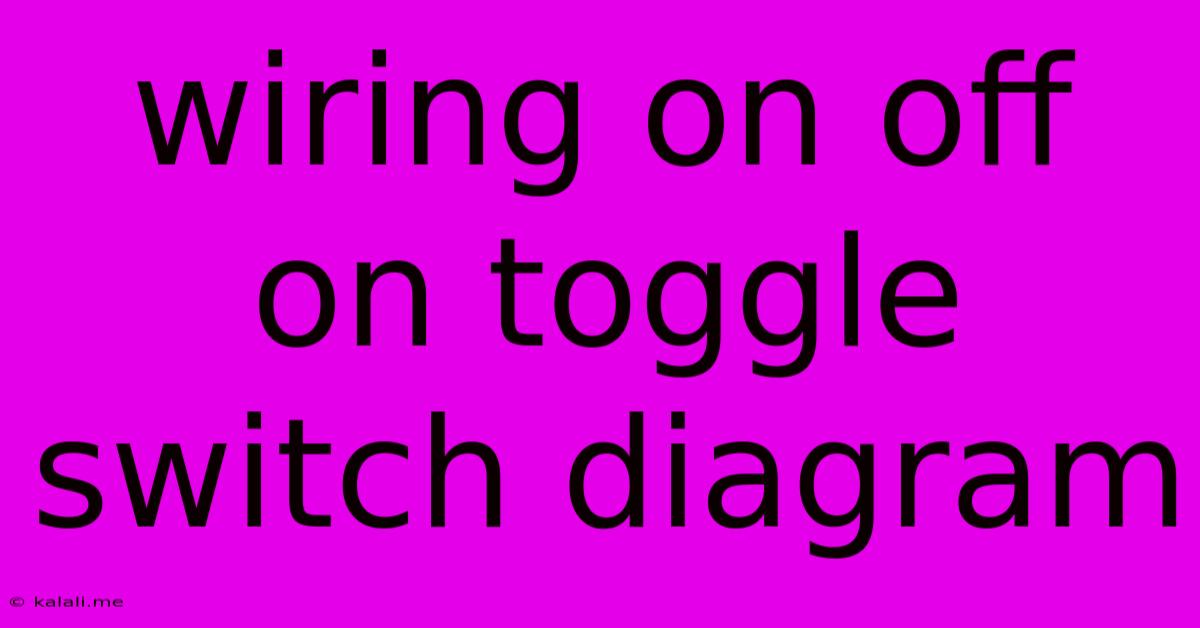Wiring On Off On Toggle Switch Diagram
Kalali
May 31, 2025 · 3 min read

Table of Contents
Wiring an On-Off-On Toggle Switch: A Comprehensive Guide
This article provides a comprehensive guide on how to wire an on-off-on toggle switch, including diagrams and explanations for various applications. Understanding the wiring is crucial for various projects, from simple lighting circuits to more complex electronic setups. We'll cover different configurations and troubleshoot common issues.
What is an On-Off-On Toggle Switch?
An on-off-on toggle switch, also known as a three-way switch or DPST (Double Pole, Single Throw) switch, has three positions: On, Off, and On. Unlike a simple on-off switch, this allows you to control a circuit in two different ways or connect to two separate circuits. This makes them versatile components in various electrical and electronic projects.
Understanding the Terminals
Before diving into the wiring diagrams, let's understand the terminals of a typical on-off-on toggle switch. They usually have three terminals, sometimes labeled differently depending on the manufacturer but generally follow this pattern:
- Common Terminal (COM): This terminal is always connected to the power source.
- On Terminal 1 (ON1): This terminal connects to the circuit when the switch is in the first "On" position.
- On Terminal 2 (ON2): This terminal connects to the circuit when the switch is in the second "On" position.
Wiring Diagrams and Applications
Here are a few common wiring configurations and their applications:
1. Controlling Two Separate Circuits:
This is a common use case for an on-off-on switch. You can control two independent circuits with a single switch.
[Power Source] ---[COM]---[ON1]---[Circuit 1]
|
|
[ON2]---[Circuit 2]
In this setup, when the switch is in the first "On" position, only Circuit 1 is powered. When it's in the second "On" position, only Circuit 2 is powered. The "Off" position disconnects both circuits. This is ideal for things like switching between two different light sources or controlling separate components.
2. Reversing Polarity:
This configuration allows you to reverse the polarity of a circuit, useful in some motor control applications or specialized electronics.
[Power Source (+)] ---[COM]---[ON1]---[Circuit (+)]
|
|
[ON2]---[Circuit (-)]
[Power Source (-)]---[ON1]---[Circuit (-)] when switch in position 1
[Power Source (-)]---[ON2]---[Circuit (+)] when switch in position 2
This arrangement allows the direction of the current flow through the circuit to be switched. Always ensure the circuit is designed to handle this reversal safely.
3. Selecting Different Power Sources:
This configuration allows you to switch between two different power sources for a single circuit.
[Power Source 1] ---[ON1]---[Circuit]
|
|
[Power Source 2] ---[ON2]---[Circuit]
|
|
[COM]----Ground
In this setup, the common terminal might be connected to ground. Selecting ON1 connects the circuit to Power Source 1, and selecting ON2 connects it to Power Source 2. This can be useful in systems requiring redundancy or different voltage levels.
Troubleshooting
If your circuit isn't working as expected, consider these troubleshooting steps:
- Check the switch: Make sure the switch itself is functioning correctly by testing its continuity in each position using a multimeter.
- Inspect the wiring: Carefully examine all connections for loose wires, shorts, or damaged insulation.
- Verify the power source: Confirm that the power source is providing the correct voltage and is turned on.
- Test the circuit: Use a multimeter to check the voltage at various points in the circuit to pinpoint the problem.
By understanding the principles and diagrams outlined above, you can confidently wire and utilize on-off-on toggle switches in your projects. Remember to always prioritize safety and use appropriate precautions when working with electricity.
Latest Posts
Latest Posts
-
How To Remove A Bathtub Drain Stopper
Jun 01, 2025
-
How Do I Wirte My Major And Study Together
Jun 01, 2025
-
You Re Welcome And Thats Good To Hear
Jun 01, 2025
-
Debris Between Steel And Wooden Footers
Jun 01, 2025
-
2 Ground Rods For 200 Amp Service
Jun 01, 2025
Related Post
Thank you for visiting our website which covers about Wiring On Off On Toggle Switch Diagram . We hope the information provided has been useful to you. Feel free to contact us if you have any questions or need further assistance. See you next time and don't miss to bookmark.